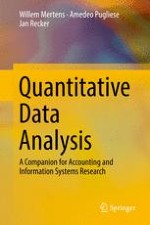2017 | OriginalPaper | Chapter
7. Causality: Endogeneity Biases and Possible Remedies
Authors : Willem Mertens, Amedeo Pugliese, Jan Recker
Published in: Quantitative Data Analysis
Publisher: Springer International Publishing
Activate our intelligent search to find suitable subject content or patents.
Select sections of text to find matching patents with Artificial Intelligence. powered by
Select sections of text to find additional relevant content using AI-assisted search. powered by
